There have been some interesting examples, recently, of how people are looking at links differently 2014. Earlier this week, Adam Mason posted a simple but effective way to calculate how “spammy” a website is, by dividing the Trust Flow of a web site with its Citation Flow. Also this week, Aussie SEO Jim Stewart used Majestic’s New Link Tracking charts to see the uptake of news about the life size (real) Lego car.
These stories are both interesting – as there is a word of warning in Majestic’s data…. something that should make it blatantly obvious that cutting corners bad for business.
Here is the link profile of a website that cut corners. The site is xkey.nl – a site with a title of “Canada Goose officiële website, Canada Goose Down – Genuine”…. I can tell you now that it isn’t…. so if you want the GENUINE Canada Goose site it is here. I won’t link to xkey.nl… but have a look at their link profile chart before we head forward.
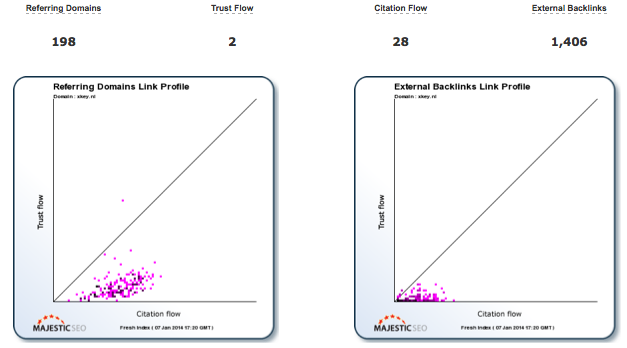
In case the image is not the way you digest data… the Trust flow is 2… the Citation flow is 28! This site has 1,406 links from 198 DIFFERENT domains and they can only create 2 points of Trust flow. The visual result is a rather limp looking flame in the chart. Let’s look at what happened here:
You need MORE data than link velocity to see black hats at work
One of the charts below is for the Lego Car and one is for the Canada Goose website. They both were created at around the same time and the charts look pretty similar. The only difference is that one of the sites is generating links in the hundreds and one is generating links in the tens…
Which one below do you think will be the spammy, fake Canada Goose site?
My guess is that most of you are just reading…. not guessing. Go on… go back and have a look at the charts and have a guess at which one is the spammy fake one before you move on.
I’ll wait….
Scroll down when you have decided….
….
….
….
….
….
My GUESS is that half of you refused to commit to a decision in that true SEO consultant “it depends” evasive manner we sometimes have as an automated defense mechanism. Then I would guess that the more you know about SEO, the more likely it is that you decided that the lower chart was the spam chart, on the basis that the links came in quickly whilst the top chart looks more “natural”.
That would be wrong. The top chart is the one with a Trust Flow of 2. the bottom chart is the lego car. It becomes REALLY obvious, though, when you compare the link profile of the two sites two sites side by side:
This profile shows the flow metrics at the domain level.
Some of the links are quite comical. I especially like this one… admittedly nofollowed… but who allows links like this on a site called “whichvirus.com”?
But that is not the WHOLE story
You can see a world of difference here between a website/webpage that generate links fast because they have a story compared to those that have automated comment spam. It is not always as clear as day like these two comparisons though. Here’s a Pills site – again from the Dutch – which has scraped together SOME apparent trust:
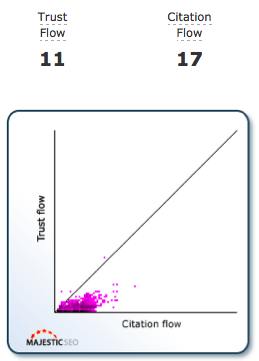 This site actually has about 7,000 links from 240 domains and one or two of them must have been good enough to be on sites of some value, to be able to generate SOME trust. True… the difference between Citation flow and Trust flow creates a red flag in my mind, but the red flag is only a question mark. Plenty of completely legitimate websites will end up with such a score – so until we dig deeper, I would not know either way. True… the anchor text is a pretty good clue:
This site actually has about 7,000 links from 240 domains and one or two of them must have been good enough to be on sites of some value, to be able to generate SOME trust. True… the difference between Citation flow and Trust flow creates a red flag in my mind, but the red flag is only a question mark. Plenty of completely legitimate websites will end up with such a score – so until we dig deeper, I would not know either way. True… the anchor text is a pretty good clue:
- order flagyl no prescription needed
- 50 mg viagra cost
- nolvadex for sale cheap
- levitra buy uk online
- buy nexium in argentina
That’s a pretty big clue there, but even the top anchor text only accounts for 0.29% of the anchor text – so looking at the anchor text spread (without the words) would pretty much not see the clear evidence. This is because the nature of the spam is more sinister, as it would appear to have involved some hacking… here’s an example and you can see the links are not in the comments of a blog this time, but in amongst some totally nonsensical text:
I think the case is made for this red flag being justified! But just in case you want another flag… how many sites have links from Bhutan?
This site has links from all over the world. This is either a truly international brand… or spam.
Want one last flag for this site?
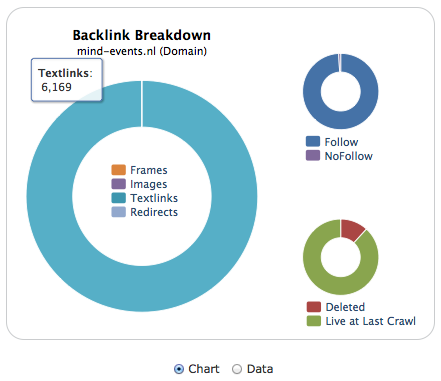 This is NOT a realistic chart. Every link is a text link. Almost every link is a follow link. That’s OK for a few links, but when you get to 6,000+ links, then you can see just how automated link building brings out not one red flag, but many.
This is NOT a realistic chart. Every link is a text link. Almost every link is a follow link. That’s OK for a few links, but when you get to 6,000+ links, then you can see just how automated link building brings out not one red flag, but many.
Let’s End on a positive
Using links to track progress is really useful – whether for SEO or for PR. Last month, James Crawford wrote a great post on using Majestic SEO for PR – and good SEO is often about good PR. The Lego car is a great one. The main project website is certainly moving up the rankings… and when all the hubbub has died down I expect them to be there, but their car and their youtube videos are all over Google’s SERPs right now:
You can’t say fairer than that can you? Let’s watch the video 🙂
James May… time to challange the Australians and Romanians with your Meccano bike…
- How Important will Backlinks be in 2023? - February 20, 2023
- What is in a Link? - October 25, 2022
- An Interview with… Ash Nallawalla - August 23, 2022







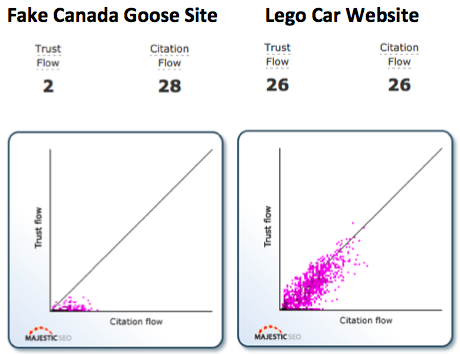
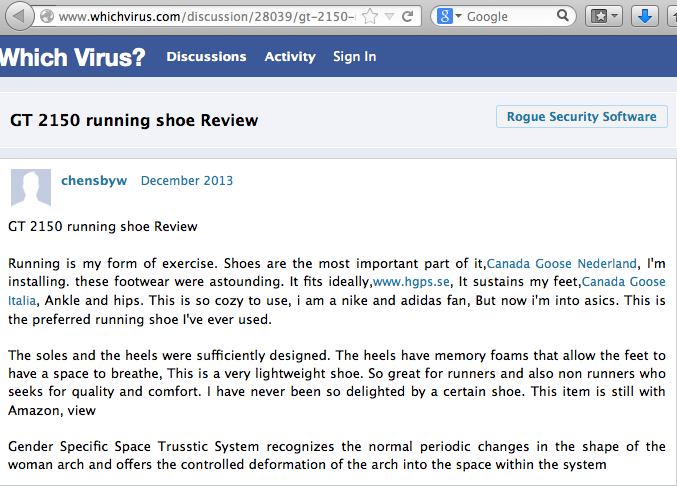

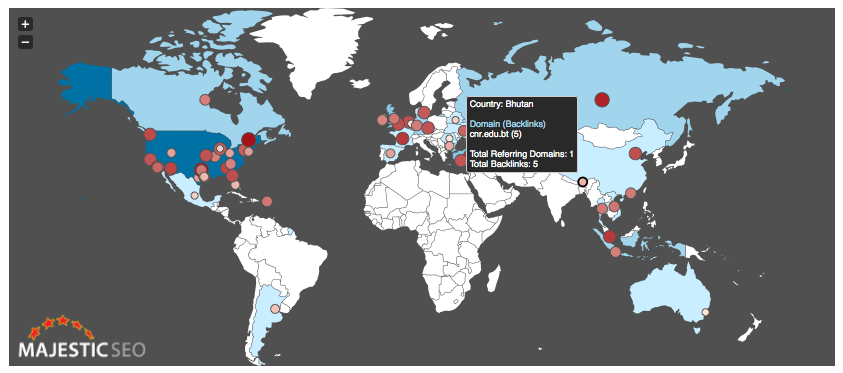
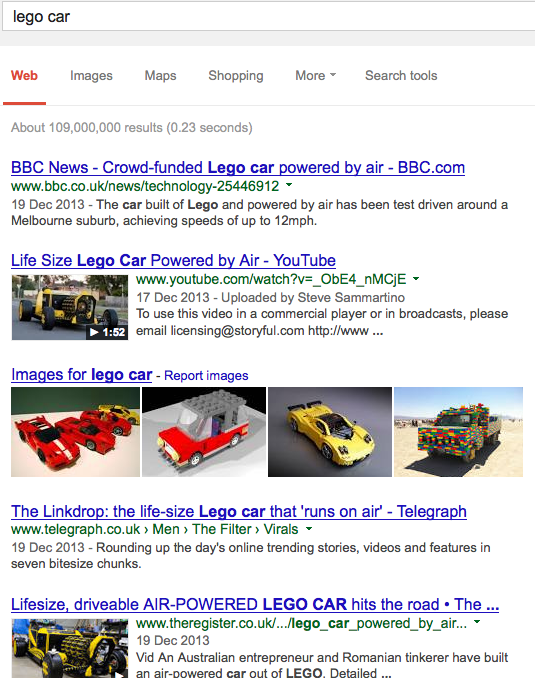
I see Majesticseo counts follow and no follow links. Spammers are interested in follow links of course, because they count for ranking.
But what about “no links”? For example, people are posting urls on forums, pastebin and so on, but these urls are not active links because they are not described as links in html (a href=”X”). So a very popular website should also have a high amount of such “no link” urls. While a spammy site should have only follow but no “no link” urls pointing on them.
So perhaps the ratio of active vs non active links could also indicate how spammy a website really is.
January 10, 2014 at 5:43 pm[This comment was corrected for some of the grammar only to make it more readable -ed.]
Hi MK,
January 11, 2014 at 1:28 pmWe actually do record these. We call them “mentions”. We assume by that users do not want these in default reports, but if you get an ADVANCED report you can then reset the filters to include “mentions”.
If you are in the habit of building low quality or spammy links then stop doing so because in 2014 it is not effective because it is harmful for your website and may penalize it due to excessive backlinks. You helps people by doing comparison between two website which are following different techniques for high ranking. One is lower in search engines and other is rank up due to natural links. Now everyone should focus on the quality of links rather than quantity.
January 12, 2014 at 7:42 amI just don’t know how to get quality links. I try to make great content but no one links to it much.
January 13, 2014 at 1:08 pmThanks for the report – 6000 follow links seem like this site did not even try to hide it was using software to build links.
January 14, 2014 at 10:34 amMost don’t. But the point here is that Link Velocity is only sometimes a signal of spam. In fact – it is not really the velocity that it is signal, as much as the impression (or lack thereof) that these links leave on the fabric of the web.
January 14, 2014 at 10:39 am